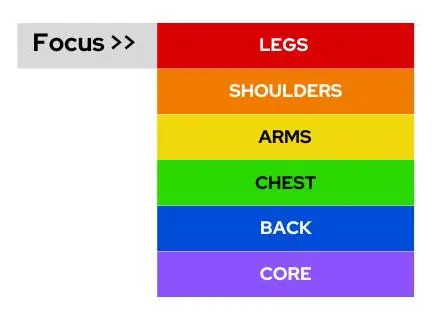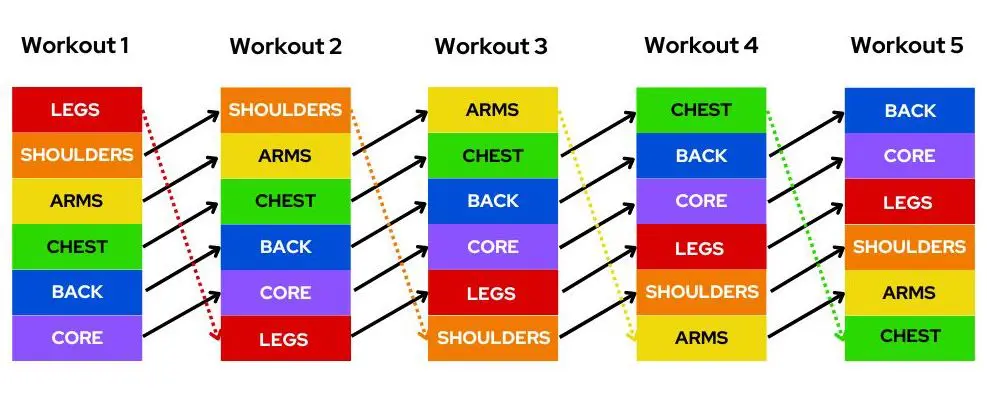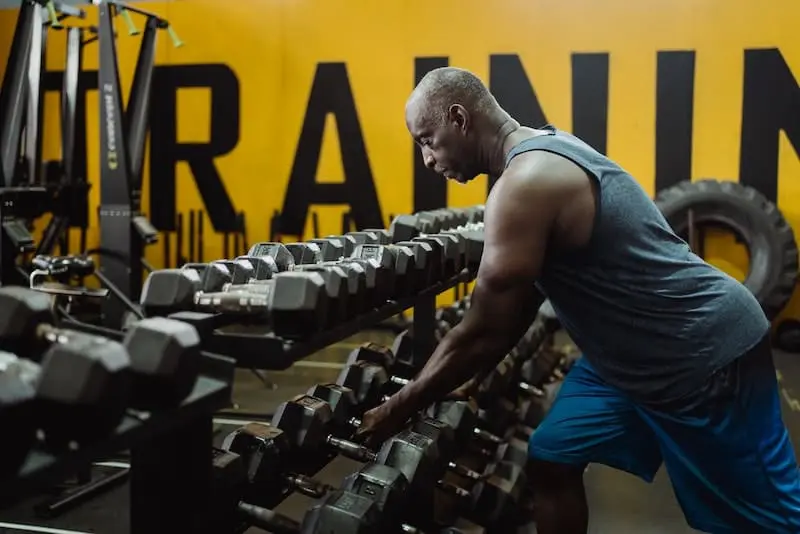
The best online fitness resource you'll ever need. We filter out the BS to ensure you meet your health and fitness goals!

The best online fitness resource you'll ever need. We filter out the BS to ensure you meet your health and fitness goals!

Our Full Body Workout Plan includes exercises that directly target key muscles as well as others that make muscles work in harmony in functional ways.
If you’re someone who wants to work every major muscle group every time you hit the gym, then this program is for you; especially if your goal is an improved, more fit, athletic-looking, and toned physique.
Jump to the workout plan now!
Alternatively, you can download the free PDF using the link below:
| Program style | Resistance training |
| Program duration | 12 weeks |
| Target Gender | Male and female |
| Target Muscles | Full body |
| Workout duration | 1-2 hours |
| Scheduling | 5 workouts |
| Goal | Workout full body and build overall muscle |
| Level | Beginners to advanced |
| Equipment | Dumbbells (DB), Barbell (BB), hex bar, resistance bands, cable machine |
You can expect your muscles to grow, and probably to get stronger, although this is not a strength training program per se.
You can also expect to be doing a lot of work. So if you’re new to the weight room, or if you’ve been doing a bro split or upper-lower split, you can expect some soreness at first until you acclimate.
Is this the program I would write for someone who’s single goal is bigger muscles without caring how often they work out?
No, it isn’t.
I prefer using splits for that. But this is ideal for people who want or need to train every muscle during the times they’re able to get into the gym. Or, for people who want a little less work per workout with the workload spread out over several days.
You can also expect to see some exercises that may be unfamiliar to you. The exercises that are here are here for a good reason: lots of personal experimentation over a 43-year period, and reviews of the legitimate peer reviewed research. Yes, there are some favorite gym-bro exercises missing.
So no, there are no back squats, traditional deadlifts, barbell bench press, cleans, barbell overhead presses, or leg raises.
I did toss in some exercises that are variants of the gym staples, as well as some optional exercises that you can pick between depending on available equipment or individual preference.
This program’s goal is muscle hypertrophy written for someone who wants to work out a lot. If you like going to the gym and feel like you need to work out more often, try this program.
Full body workouts are a good approach for people who look for general fitness and a more fit-looking physique without getting too terribly crazy about it. They’re also really good for middle-aged people who want to get into the gym three or four times a week and not overdo it.
Full body workout plans like this one are also great for traveling professionals who may find themselves in a hotel that has a complete gym one night, but the next night’s in a hotel with no fitness facility at all.
The plan divides the body into the major body parts we often think of with Bro Splits: Legs, Shoulders, Arms, Chest, Back. Core has been added.
Each body part–except Core–gets a focus day.

The focus day is “heavy day”. Where other body parts have only one exercise per day, focus day has several. Legs for instance, there are exercises that address each of those.
In the workout to follow a “focus day”, the focus body part rotates to last, and the body part that follows the focus body part moves up to its focus day.

Set and rep schemes have been intentionally set so that the day after focus day is lighter and accommodates recovery.
Leg Day done correctly will be your hardest day of the week from a work standpoint. Working legs is hard.
The exercises selected for Legs were specifically chosen to deliver direct hits to each particular region of the upper leg: quads, hamstrings, and glutes.
Note how we’ve placed hamstrings between two exercises for quads? That is intentional.
I learn through experimentation that if I put an opposing muscle exercise between two specific exercises for a muscle (e.g. quad, ham, quad) that I could get further productive work out of that target muscle.
My quads weren’t as fatigued as I thought they were!
This isn’t effective with all muscle groups. The quads can take it. I found that this worked for my heavy leg days so I’m sharing the hack here.
We follow our lower body Leg Day with an upper body focus, Shoulder Day. The legs get a bit of a breather during this workout.
Arms are next, divided into triceps, biceps, and forearms. Forearms are featured with arms on this focus day only. You’ll be getting plenty of forearm work during the other arm and back days.
Shoulders move down to last for some light work following their focus workout yesterday or the day before.
Chest is intentionally separated by one workout from shoulders to allow your anterior delts to bounce back and be fresh, since anterior delts get some work with chest almost no matter how hard we try. (It is possible…just challenging).
The pec major muscle (aka “the chest”) is fan shaped and because of this, it attaches along a lengthy region of the middle chest: collar bone, sternum, and upper ribs.
Those are–in order–the clavicular, sternal, and costal attachments. We combine sternal and costal into one “regional” attachment of the pec major.
Each chest exercise aligns resistance against a specific direction of pull from the pec major’s origin on the upper arm bone (humerus) and its insertion along the clavicle, sternum, or ribs.
The three exercises we have for you here will work the pec from top to bottom. Concentrate on strict form and don’t let your ego get in your way. Use light weights if you need to in order to see the muscle building benefits.
“Back” is divided here into lats, middle and lower traps, and muscles of the posterior shoulder, most notably the posterior delts. This is because a number of the popular back exercises strongly rely on shoulder extension–pulling the upper arm back.
The Lat Pull-in, which appears in this program, is biomechanically best at taking the posterior shoulder out of the equation. Pull-downs are second best for this.
Traditional rows rely very heavily on extension of the shoulder, so the lats aren’t isolated.
Finally, the biggest, potentially beefiest portion of the back are the middle and lower traps which lie between and just below your shoulder blades.
Those muscles are responsible for pulling your shoulder blades back, together, and down.
There are exercises in this program that concentrate on that specific movement.
It might be a good idea to force one of your rest days between Back focus day and Legs.
Back will be your second-most strenuous workout if it’s done correctly, and you’ll want to be fully recovered when you cycle back to Legs next.
You’ll notice that there are no rest days specified, and the workouts aren’t assigned to a specific day of the week. That is intentional.
The five workouts can be spaced however you like and however your schedule allows, as long as you follow a few basic guidelines.
Work out at least three days per week, and don’t work out seven days a week.
Here are a couple of suggested workout day cadences:
You can get fancier than that if you like…
The point is that you’re going to be doing a lot of work by following this program. If you’re taking the last one or two sets of each exercise to mechanical muscle failure, you could very easily overtrain.
Which means you’ll plateau, get hurt, or worse, get smaller. Yes, that can happen. You need recovery (and good nutrition of course).
Arrange workouts so that you’re getting through all five workouts at least three times a month. That math has you following a basic Day On/Day Off cadence. Personally, I would aim for four to five rotations per month, assuming you’re recovering adequately between the workouts.
Warm up before your workout to prevent injury and practice the movements. Warm-ups are important for anyone and even more crucial for older adults.
If you’re a newcomer to the gym but a veteran in another sport, you’ll already understand the value of a good warm-up.
You should also get in the habit of stretching the target muscles before actually targeting them. This program will target basically every single muscle you have in your body, so getting those muscle loose is crucial.
There’s nothing worse than getting started on a heavy set of bench press and pulling a pectoral muscle, which could have easily been prevented with some simple chest stretches.
A good warm up for a full body workout plan would follow something like this:
| Warm up exercise | Reps |
|---|---|
| Unloaded squats, TRX or bodyweight | 30 to 50, or until knees are warm and loose |
| Arm circles, bodyweight. Forward | 20 to 25, or until shoulder joints are warm and loose |
| Arm circles, bodyweight. Backward | 20 to 25, or until shoulder joints are warm and loose |
As mentioned previously, each major body part receives a “focus day” with more overall workload.
The rotation through your focus days works like this:
That focus body part then rolls off to the bottom of the list for the next workout where it receives a lot less work as compared to its focus day. You’ll see that the rep count is higher and there are also fewer sets. That’s with recovery in mind.
Core work is included each day’s workout, there’s just no focus day for it.
Muscles of the posterior shoulder are so involved in back work, rear delts are part of Back day in this program.
| Exercise | MUSCLE | Set 1 | Set 2 | Set 3 | Set 4 |
| Sissy Squats, or Sissy Hack Squats, or DB Heel Elevated Squats | Quads | 15-20 | 10-12 | 10-12 | 10-12 |
| Leg Curls | Hamstrings | 15-20 | 10-12 | 10-12 | 10-12 |
| Leg Extensions | Quads | 15-20 | 10-12 | 10-12 | 10-12 |
| Multi-Hip Machine, or Cable Hip Extensions, or RDLs | Glutes | 15-20 | 10-12 | 10-12 | 10-12 |
| Single Leg DB Calf Raises | Calves | 15-20 | 15-20 | 15-20 | 15-20 |
| Lu Raises, Plate Raises, or DB “I” Raises | Delts, Upper traps | 20 | 15-20 | 12-15 | 10-12 |
| Flat bench Lying Triceps Extensions | Triceps | 20 | 15-20 | 12-15 | 10-12 |
| Hammer Curls | Biceps, Forearms | 20 | 15-20 | 12-15 | 10-12 |
| Flat DB Bench Press | Pec major | 20 | 15-20 | 12-15 | 10-12 |
| Cable Pull-Downs | Lower traps, Lats | 20 | 15-20 | 12-15 | 10-12 |
| Crunches, Flat | Rectus abdominis | 20-30 | 20-30 | 20-30 | 20-30 |
| Exercise | MUSCLE | Set 1 | Set 2 | Set 3 | Set 4 |
| Cable Side Raises | Middle delts | 15-20 | 10-12 | 10-12 | 10-12 |
| Cable Front Raises (Thumbs-up) | Anterior delts | 15-20 | 10-12 | 10-12 | 10-12 |
| Supine Grip Triceps Cable Push-downs | Triceps | 15-20 | 15-20 | 15-20 | 15-20 |
| DB Concentration Curls | Biceps | 15-20 | 15-20 | 15-20 | 15-20 |
| Low Incline DB Bench Press | Anterior delts, Pec major | 20 | 15-20 | 12-15 | 10-12 |
| Cable Kelso Shrugs (Scapula Shrugs) | Middle and Lower traps | 20 | 15-20 | 12-15 | 10-12 |
| Cable Oblique Side Pulls | Obliques | 20-30 | 20-30 | 20-30 | 20-30 |
| Walking Lunges (BW or very light DBs) | Quads, Glutes | 20 | 20 | 20 |
| Exercise | MUSCLE | Set 1 | Set 2 | Set 3 | Set 4 |
| Triceps Cable Push-downs (V-Bar or EZ Curl) | Triceps | 15-20 | 10-12 | 10-12 | 10-12 |
| Single Side Cable Curls | Biceps | 15-20 | 10-12 | 10-12 | 10-12 |
| Seated DB or BB Wrist Flexions | Forearms | 15-20 | 10-12 | 10-12 | 10-12 |
| Underhand DB Flat Bench Press | Pec major | 15-20 | 15-20 | 15-20 | 15-20 |
| Chest Supported rows (machine or incline bench with DB) | Lats, Middle and Lower traps, Posterior shoulder | 15-20 | 10-12 | 10-12 | 10-12 |
| Crunches | Rectus Abdominis | 20-30 | 20-30 | 20-30 | 20-30 |
| “B” Stance DB RDLs | Glutes, Hamstrings | 12-15 | 12-15 | 12-15 | 12-15 |
| Chest Supported Rear DB Flyes, incline bench, face down. Neutral or pronated grip (palms toward floor). | Posterior delts | 15-20 | 15-20 | 15-20 |
| Exercise | MUSCLE | Set 1 | Set 2 | Set 3 | Set 4 |
| Decline DB Presses, Decline Cable Presses, or Decline Converging Chest Press Machine | Pec major, sterno-costal head bias | 15-20 | 10-12 | 10-12 | 10-12 |
| Low-to-High Cable Flyes | Pec major, clavicular head bias | 15-20 | 10-12 | 10-12 | 10-12 |
| High-to-Low Cable Flyes | Pec major, sterno-costal head bias | 15-20 | 10-12 | 10-12 | 10-12 |
| Seated Cable Rows, Wide Grip | Lats, Middle and Lower traps, Posterior shoulder | 15-20 | 15-20 | 15-20 | 15-20 |
| Sit-ups with a twist | Rectus abdominis, Obliques, Transverse abdominis | 20-30 | 20-30 | 20-30 | 20-30 |
| RFE “Bulgarian” Split Squats | Quads, Glutes | 15-20 | 15-20 | 15-20 | 15-20 |
| Seated Underhand DB Presses (palms facing body) | Anterior delts | 15-20 | 10-12 | 10-12 | 10-12 |
| Reverse Grip Cable Triceps Extensions | Triceps | 15-20 | 15-20 | 15-20 | |
| DB Biceps Curls (Alternating Arms, Seated) | Biceps | 15-20 | 15-20 | 15-20 |
| Exercise | MUSCLE | Set 1 | Set 2 | Set 3 | Set 4 |
| Cable Pull-ins, or Cable Pull-Downs | Lats | 15-20 | 10-12 | 10-12 | 10-12 |
| Chest Supported Row Machine or Chest Supported T Bar | Middle and Lower traps, Lats, Posterior shoulder | 15-20 | 10-12 | 10-12 | 10-12 |
| Cable Shoulder Extensions (Rear Delt Flyes), Single Arm | Posterior delts | 15-20 | 10-12 | 10-12 | 10-12 |
| Crunches, (Flat or Incline) | Rectus abdominis | 20-30 | 20-30 | 20-30 | 20-30 |
| Reverse Lunges | Glutes, Quads | 12-15 | 12-15 | 12-15 | 12-15 |
| Cable Upright Rows | Middle delts, Upper traps | 15-20 | 10-12 | 10-12 | 10-12 |
| Neutral Grip Cable Triceps Extensions (Single or both arms) | Triceps | 15-20 | 10-12 | 10-12 | 10-12 |
| Palms-Up DB Biceps Curls | Biceps | 15-20 | 10-12 | 10-12 | 10-12 |
| Flat DB bench press | Pec major, Anterior delts | 15-20 | 15-20 | 15-20 |
You’ll find a blend of single-joint, isolation exercises and multiple joint, compound exercises in this program. Notice that the focus days rely mostly on the single-joint variety.
I programmed “direct hit” exercises on focus days. Those are almost in every case isolation exercises that load the target muscles without its companion muscles helping. You’ll be working the target muscle exclusively on focus days.
An example of a direct hit exercise would be a sissy squat for quads. The glutes and hams aren’t helping.
Body parts that are not focused on during a workout include some compound “indirect hit” exercises. These are exercises that may (and probably do) involve more than just the target muscle.
An example of an indirect hit exercise would be a Lu Raise. The deltoids do a lot of the work but then here come the upper traps along at the end of the motion. They get some work too.
Point being that the Lu Raise is not an exclusively deltoid exercise, where the cable side lateral is a middle delt isolator and therefore (using my term) a “direct hit” to the middle delt. So the cable side lateral shows up on Shoulder focus day.

Apply progressive overload throughout. Hit the rep range then raise the weight. Repeat.
Do the specified number of reps with a weight you can move with excellent form until you can do more reps than written, and then increase the load. Very simple and it always works.
Tons of data support progressive overload. No need to go looking for another exercise to break a plateau. Do more reps, then do more weight. Rest enough between sets to allow yourself to practice progressive overload within a single workout.
On your focus days, take the last two sets of each exercise to failure. “Failure” means inability to perform another rep with good form.
The last couple of reps will be and should be hard. As in grinding-out-moving-really-really-slow hard.
For other body parts not getting focus, it’s OK to leave a rep or two in the tank, meaning 1 to 2 RIR (Reps in Reserve). Reps “left in the tank” is RIR, Reps In Reserve.
For the “on deck” body part–the one that’s getting its focus day the next workout, RIR is a bit higher, 1 to 2 Reps In Reserve. That RIR is intended to have those muscles worked, but fresh for the next workout when they get their time in the spotlight and pushed to their limits.
A lot of guys (and gals), especially the noobs, really have no idea how far they can push themselves into a set while still using good form. Knowing exactly how many more reps you actually could do takes a long time and a lot of practice.
One practical way to learn this is to not stop a set when you get to the written end of a rep range. If the program says 10 to 12 reps, and you get to 12, if you think you can keep going with good form, do!
Make a note of how many more great reps you did, then on the next set, raise the weight so that you’re only able to squeeze out that 11th or 12th rep and not a bit more.
Approach each workout with intensity. Intensity doesn’t mean looking intense, like putting on a scowl or wearing a hoodie over your head, slinking around the gym. Have a purpose. Concentrate on every rep of every set.
And for Arnold’s sake, please please put your phone away. Leave it in the locker or your car or at home. Looking at your phone between sets is a poser move.
If your workout isn’t important enough to make it your center of attention for an hour or so, then can we just be honest with ourselves and admit that you’re probably not going to be getting those muscles you want. I mean, really.
Perform all your reps in a rhythmic, controlled fashion but without timing them. No 1 second up 2 seconds down kind of methodology.
Pick a weight that you’re pulling or pushing hard yet heavy enough that the weight isn’t moving fast.
Mechanical tension and its duration is one of the cornerstones of resistance exercise (Krzysztofik et al, 2019, International Journal of Environmental Research and Public Health). Don’t compromise your results by using terrible form.
Do not use momentum. Do not kip. Do not launch. Don’t time your sets.
Let’s quickly discuss rest between sets, intra-workout recovery (as contrasted with inter-workout recovery, the recovery between whole workouts).
How long should you wait before doing your next set, or your next exercise? It may be longer than you think.
Research says that longer rest periods between sets beats shorter rest times when it comes to muscle-building
Personally, I’m not a fan of watching a clock. I tell my clients to do the next set once they feel they can do it with intensity that meets or beats the previous sets’ intensity. Turns out that’s usually 2 to three minutes.
If you are a clock-watcher, 3 minutes between sets is a good rule of thumb if your sets are intense enough. It’s much better to condition yourself not to rely on external cues like apps or clocks.
The best learn to read their internal cues to know when it’s time to get after it again.
Here’s a tip for gauging your rest times: after you finish a set, check the clock. Look away until you feel like you can kill the next set.
Then, look up at the clock again to see how much time has passed. My guess is that it’s going to be 2 to 3 minutes…assuming the set you just finished was done properly and with enough intensity.
Will you spend longer times in the gym? Maybe.
However, if you’re adequately rested between sets you’ll be better able to perform sets that are sufficiently strenuous to provoke muscle growth.
Think set quality and not set quantity. (I’m not saying fewer sets are better. I am saying that people probably do more sets than needed and the ones they do aren’t loading the muscle as much as they could be if properly rested.)
A full body workout offers a lot of flexibility for people with busy lifestyles, who want–or need–to work every muscle group in the body when they’re in the gym. Full body workouts are also a good choice for people whose muscles need more coaxing.
This isn’t the only Full Body workout available. For another excellent FB program, check out Abel Body’s Hardgainer Solution. That program features combinations of exercises into supersets, a very interesting approach, especially for middle-aged exercisers.
Download our Full Body Workout Plan PDF here: